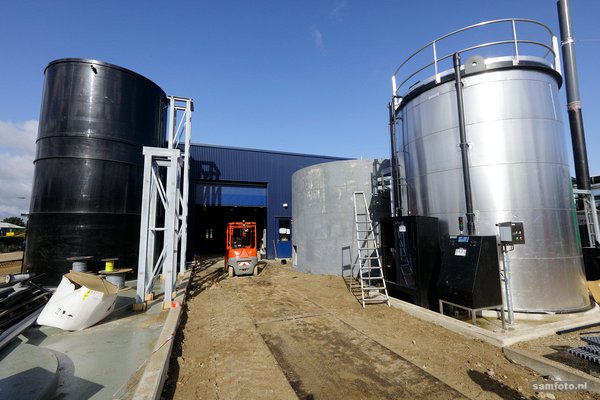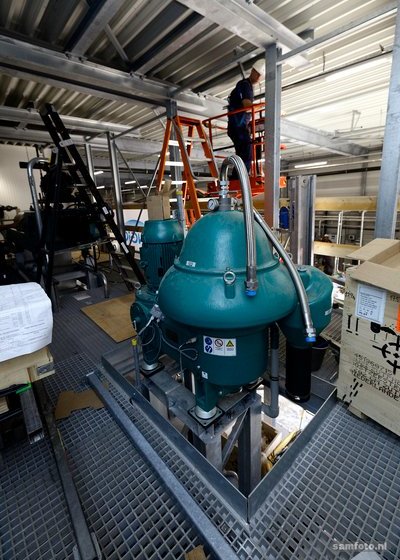Lucky find becomes top material
Researchers at Delft have discovered a versatile raw material that is created during the ‘Nereda’ wastewater treatment process. The first factory for recovering this dry or gum-like substance, called Kaumera, recently opened in Zutphen. Its potential uses range from seed coating to composite materials.
We visited the modest production hall in the Zutphen factory, next to the wastewater treatment plant, where fitters, welders and technicians were busy putting the finishing touches to the world’s first Kaumera extraction plant. This collection of processing plants, including a belt thickener, heat exchanger, reactor, centrifuges and storage silo will soon be producing a brand-new raw material.
“This is the first time we are extracting a totally new material from wastewater’, says Sandra de Wit, policy advisor at the Rijn en IJssel Water Authority, who is convinced of its great potential. The material was discovered purely by chance a few years ago by TU Delft researchers. They decided to call it Kaumera, which means chameleon in Maori, the language of the indigenous people of New Zealand.
De Wit: “Just like a chameleon, this material can adapt to its surroundings, which makes it very versatile.”
One customer has already been found: the Amsterdam biotech company Chaincraft. Potential uses for Kaumera include seed coatings in the agricultural sector, concrete coating in the construction sector and composite materials for the automotive industry. Around a third of all waste sludge can be put to good use for Kaumera production, rather than ending up in a waste incinerator or processor.
By-product of Nereda
Kaumera is not formed during every wastewater treatment process, it is a by-product of a new wastewater treatment technology called Nereda. This technology was also originally developed by TU Delft researchers, who discovered a special bacterial treatment for waste sludge that causes it to settle in granules rather than flakes. This accelerates the settling process so fewer storage tanks are needed and the entire plant takes up less space. The technology has been further developed in recent years by RoyalHaskoningDHV and is now in use at seventy locations worldwide.
Brainchild
The Nereda technology is the brainchild of Mark van Loosdrecht, Professor of Environmental Biotechnology and winner of the Spinoza Prize. He came across the PhD research of Yuemei Lin from China, who discovered an alginate-like substance in sludge granules. Alginate is used as a raw material for bioplastic, that is usually produced from seaweed.
“The substance resembles alginate, but has a completely different composition”, says Van Loosdrecht. “It has high rigidity, is very strong and non-combustible, a unique combination of properties that makes it suitable for high performance materials, such as fire doors, ship coatings and materials in the aeronautical and automotive industries.”
The material can also be produced on a larger scale than alginate from seaweed, making it considerably cheaper. “If all the existing Nereda plants were to produce Kaumera, this would already equal the current volume of the total alginate market”, says Van Loosdrecht. The collaboration with Chaincraft, which will be purchasing the total production for the first two years, is expected to eventually lead to a cost-effective investment.
Single source
The plant in Zutphen takes its wastewater from a single source: the FrieslandCampina dairy plant in Lochem. A sewer pipe that formerly transported the wastewater to the adjacent treatment plant, has been diverted to feed directly into one of the new Nereda tanks where the granulate is produced that is then fed through the new extraction plant to produce Kaumera.
In early 2020, another Kaumera plant will start operating in Epe that will also process domestic wastewater; so not only factory wastewater, but also our own faeces and urine will be given a new and useful lease of life. Van Loosdrecht: “It’s really great that with a little creativity we can create high-performance materials from something that you flush down the toilet.”
Does the discovery of Kaumera equal that of graphene, the two-dimensional carbon material that earned the Dutch-British physicist Andre Geim the Nobel Prize in Physics? Van Loosdrecht hesitates. “I would rather let others be the judge of that. But a comparison may be made with the playful aspect of the discovery of graphene, where Friday afternoons were spent working on crazy ideas.” He feels that this discovery shows that even research that doesn’t have a previously defined goal can be useful. “When we started this work it not a fashionable subject. We just wanted to know more about the bacteria involved; we had no idea we could use it to create a material. That was pure serendipity.”
* Rijn en IJssel and Vallei en Veluwe Water Authorities, TU Delft, RoyalHaskoningDHV, Chaincraft, Stowa, Energy and Resources Factory, Koploperwaterschappen and the EU Life Programme

